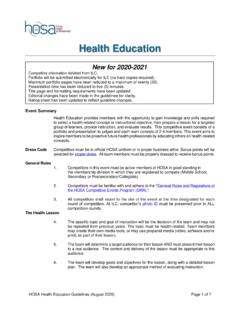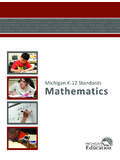Transcription of Lesson Plan Template for Science Lessons using the 5E ...
1 Lesson Plan Template for Science Lessons using the 5E Instructional Model Grade 2 Cluster 4: Air and Water in the Environment Essential Question: What happens when the snow melts? Where should we collect our data to Number 1. observe the spring thaw? Lesson Objective: To get acquainted with the schoolyard as a green space and decide on observation locations. Knowledge SLOs 2-4-06 Observe and identify examples of water in the environment. 2-4-07 Describe evidence of water changing state, and recognize that these changes are part of the water cycle. Cluster 0 SLOs 2-0-4a Follow simple directions; 2-0-4e. Respond to the ideas and actions of others in building their own understandings.
2 2- 0-4f. Work in a variety of cooperative partnerships and groups. 2-0-4g. Verbalize questions, ideas, and intentions during classroom activities. 2- 0-4h. Follow given safety procedures and rules. 2-0-8a. Recognize that learning can come from careful observations and investigations. 2-0-9a. Willingly consider other peoples views. 2-0-9b. Express enjoyment when sharing and discussing Science -related experiences from daily life. Materials (with quantities) for a group of 24 students 8 scavenger hunt sheets, laminated; 8 markers; 8 clipboards; 1 whistle Engagement Phase Time needed (minutes). Begin in circle. Inform students we are starting an exploration of how snow melts.
3 Where does it go? We will be measuring the snow as it melts and recording data in our Science journals (the water cycle and the spring melt mayhem booklets) along with digital pictures of our observations to figure out what happens to the CHECK LIST. dirt and snow as it thaws. Did Students retrieve knowledge /. Review the water cycle (evaporation, condensation, precipitation song-sung to Darling Clementine- ideas / preconceptions Evaporation, condensation, evaporation on my mind. It is called the water cycle and its happening all the from long term memory time. Evaporation, condensation, evaporation on my mind. Accumulation is the last step and the water cycles express interest /.)
4 Fine. curiosity ask questions Are there any student questions they want answered? know the objective(s) of the Lesson Have students form groups of 3. Inform them we are going to start with a scavenger hunt. They will need to know what they were to work together in order to find as many clues as possible within 15 minutes. They are not to collect the items do in the Exploration but to find them. They can record what they have found on the hunt sheet. Phase SAFETY: Do not pick up anything that can cut them such as sharp metal or broken glass. A whistle with 3 blows means to return to the tarmac. Remind them to look for a group location for data collection on the spring melt, no two groups the same.
5 Locations must be suitable for observations, no spots with little snow or too much snow that we could not measure the depth. Hand out one scavenger hunt sheet and one marker per group. Get dressed and move outdoors. Exploration Phase Time needed (minutes). Winter Scavenger Hunt. Allow at least 15 minutes for students to find as many items as possible. It is not CHECK LIST. necessary to find all the items, but as many as possible. Do not pick them up, record on the sheet. Remind Did Students them to look for a location their group wants to use for the spring melt observations. actively engage with new material work together on task explore each other's questions / ideas /.
6 Possibilities (predictions). record observations record measurements Explanation Phase Time needed (minutes). Return to the classroom. Discuss the scavenger hunt and what the students may have found. Have groups present their location and data collection. Why did the group chose this location? CHECK LIST. Did Students Possible new vocabulary present data Observation Data collection use data as evidence Measurement to justify claims meaningfully apply previous concepts learned listen respectfully to the Lesson Plan Template for Science Lessons using the 5E Instructional Model ideas of others question explanations detect patterns or trends in the data use new vocabulary develop their understanding / skills Recording (writing / drawing); Closure; Link to next session Time needed (minutes).
7 Teacher writes down each groups location and informs students we will begin our observations next Science Lesson . CHECK LIST. Did Students demonstrate (on paper). their conceptual understanding meaningfully apply what was learned to previous concepts learned understand the focus of the next Science Lesson know what question(s). to ask / knowledge to share with friends and family Lesson Plan Template for Science Lessons using the 5E Instructional Model Grade 2 Cluster 4 : Air and Water in the Environment Essential Question What is happening out there? Number 2 and 3. Lesson Objective To observe and take measurements begin to think about where the water is headed.
8 Knowledge SLOs 2-4-01 Use appropriate vocabulary related to the water cycle. 2-4-06 Observe and identify examples of water in the environment. 2-4-07 Describe evidence of water changing state, and recognize that these changes are part of the water cycle. 2-4-12 Identify substances that pollute water, and describe ways of reducing such pollution. Cluster 0 SLOs 2-0-4a Follow simple directions; 2-0-4e. Respond to the ideas and actions of others in building their own understandings. 2- 0-4f. Work in a variety of cooperative partnerships and groups. 2-0-4g. Verbalize questions, ideas, and intentions during classroom activities. 2- 0-4h.
9 Follow given safety procedures and rules. 2-0-8a. Recognize that learning can come from careful observations and investigations. 2-0-9a. Willingly consider other peoples views. 2-0-9b. Express enjoyment when sharing and discussing Science -related experiences from daily life. Materials (with quantities). 24 water cycle and the spring melt mayhem booklets, 8 small garden trowels, 8 cameras, 8. thermometers, 8 rulers, 8 pencils and 8 clipboards Engagement Phase Time needed (minutes). Begin in circle. Review water cycle. Have students remember where CHECK LIST. their chosen location is (previously written down by teacher). Have Did Students students form their previous groups.
10 Inform them we are going to begin retrieve knowledge /. ideas / preconceptions collecting data for the spring melt. Decide on who will record, who will from long term memory take measurements and who will take pictures. These jobs will rotate as express interest /. curiosity we are going to repeat this 3 times as the snow melts throughout the ask questions month. know the objective(s) of the Lesson know what they were to Are there any questions students want answers for? do in the Exploration Phase Hand out 8 booklets, 8 cameras, 8 thermometers, 8 rulers, 8 small garden trowels, 8 pencils and clipboards. Get dressed and go find locations.


